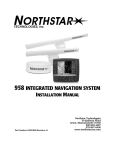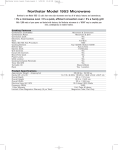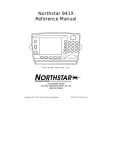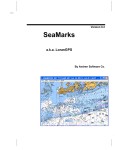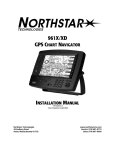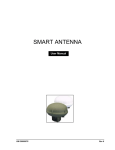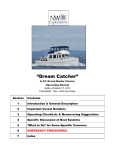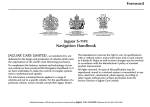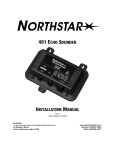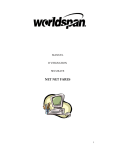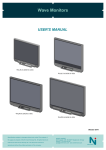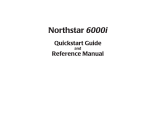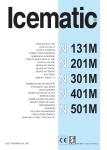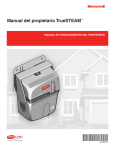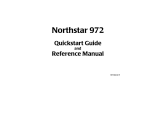Download North Star GM9571M User's Manual
Transcript
957 GPS/WAAS CHART NAVIGATOR INSTALLATION MANUAL Revision C1 Part Number GM957IM Northstar Technologies 30 Sudbury Road Acton, Massachusetts 01720 800/628-4487 978/897-6600 www.northstarcmc.com Limited warranty policy Northstar Technologies, Inc. warrants the Northstar 957 to be free from defects in materials and workmanship for a period of two (2) years. This warranty applies to the original purchaser and to any subsequent owner during the warranty period, which begins on the date of shipment of the unit, F.O.B. Acton, Massachusetts, to an authorized Northstar dealer. Systems may not be returned to Northstar without a Returned Materials Authorization (RMA) number. Call the Northstar dealer or Northstar for instructions. During the unit’s warranty period, Northstar will repair or replace, at its option, any part of the unit it finds to be defective due to faulty material(s) or workmanship. All such repairs and/or replacements will be promptly performed by Northstar free-of-charge to the owner, excluding freight costs incurred in shipping to the factory. Return shipments from Northstar to points within the United States are made via ground transportation, freight prepaid. Special shipping charges (overnight, two-day, and so on) are the responsibility of the owner. To be covered by this warranty, the Northstar equipment must have been in normal use. This warranty does not apply to units with defects caused by improper installation, physical damage, abuse, tampering, lightning or other abnormal electrical discharge, or to units with defaced or altered serial numbers, or to units repaired by unauthorized persons or repaired in a manner that violates Northstar’s recommended service procedures. All repairs and/or replacements made under this warranty must be performed at Northstar’s facilities in Acton, Massachusetts. Performance of warranty work elsewhere will not be authorized, and Northstar will not pay for any charges for such work. Northstar will not be responsible for payment of any charges imposed by a Northstar dealer or other party for services requested by and/or performed for a unit’s owner in connection with this warranty. Such services might include removal of the unit from a vessel, inspection, packaging, handling, reinstallation, and the like. Northstar Technologies assumes no responsibility for any consequential losses of any nature with respect to any of its products or services sold, rendered, or delivered. The foregoing is the only warranty expressed or implied. No other warranty exists. Contents SECTION ONE: Introduction . . . . . . . . . . . . . . . . . . . . . . . . . . . . . . . . . . . . . . . . . . . . . . . . 1 Welcome to the Northstar 957 . . . . . . . . . . . . . . . . . . . . . . . . . . . . . . . . . . . . . . . . . . . . . . . . . Who should read this manual . . . . . . . . . . . . . . . . . . . . . . . . . . . . . . . . . . . . . . . . . . . . . . . . . Scope of this manual . . . . . . . . . . . . . . . . . . . . . . . . . . . . . . . . . . . . . . . . . . . . . . . . . . . . . . . . . Major installation steps . . . . . . . . . . . . . . . . . . . . . . . . . . . . . . . . . . . . . . . . . . . . . . . . . . . . . . . ... ... ... ... . .1 . .1 . .2 . .2 SECTION TWO: Installing and wiring the 957 . . . . . . . . . . . . . . . . . . . . . . . . . . . . . . . 5 Safety considerations . . . . . . . . . . . . . . . . . . . . . . . . . . . . . . . . . . . . . . . . . . . . . . . . . . . . . . . Bench-testing the 957 . . . . . . . . . . . . . . . . . . . . . . . . . . . . . . . . . . . . . . . . . . . . . . . . . . . . . . Mounting the 957 . . . . . . . . . . . . . . . . . . . . . . . . . . . . . . . . . . . . . . . . . . . . . . . . . . . . . . . . . . Wiring the 957 . . . . . . . . . . . . . . . . . . . . . . . . . . . . . . . . . . . . . . . . . . . . . . . . . . . . . . . . . . . . . .. .. .. .. ... ... ... ... . .5 . .6 . .6 .13 SECTION THREE: Installing and wiring the 2201 . . . . . . . . . . . . . . . . . . . . . . . . . . . 17 Introducing the 2201 . . . . . . . . . . . . . . . . . . . . . . . . . . . . . . . . . . . . . . . . . . . . . . . . . . . . . . . . . . . . .17 Installing the 2201 . . . . . . . . . . . . . . . . . . . . . . . . . . . . . . . . . . . . . . . . . . . . . . . . . . . . . . . . . . . . . . .18 Wiring the 2201 . . . . . . . . . . . . . . . . . . . . . . . . . . . . . . . . . . . . . . . . . . . . . . . . . . . . . . . . . . . . . . . . .21 SECTION FOUR: Installing and wiring the 2701 . . . . . . . . . . . . . . . . . . . . . . . . . . . . 25 Introducing the 2701 . . . . . . . . . . . . . . . . . . . . . . . . . . . . . . . . . . . . . . . . . . . . . . . . . . . . . . . . . Installing the 2701 . . . . . . . . . . . . . . . . . . . . . . . . . . . . . . . . . . . . . . . . . . . . . . . . . . . . . . . . . . . Wiring the 2701 . . . . . . . . . . . . . . . . . . . . . . . . . . . . . . . . . . . . . . . . . . . . . . . . . . . . . . . . . . . . . Installing the AN205-P antenna . . . . . . . . . . . . . . . . . . . . . . . . . . . . . . . . . . . . . . . . . . . . . . . . ... ... ... ... .25 .26 .27 .28 SECTION FIVE: Checking out the system . . . . . . . . . . . . . . . . . . . . . . . . . . . . . . . . . . . 31 Inserting a chart cartridge . . . . . . . . . . . . . . . . . . . . . . . . . . . . . . . . . . . . . . . . . . . . . . . . . . . . . . . .31 Turning the 957 on and off . . . . . . . . . . . . . . . . . . . . . . . . . . . . . . . . . . . . . . . . . . . . . . . . . . . . . . . .33 Installation-test checklist . . . . . . . . . . . . . . . . . . . . . . . . . . . . . . . . . . . . . . . . . . . . . . . . . . . . . . . . . .37 SECTION SIX: Interfacing the 957 system . . . . . . . . . . . . . . . . . . . . . . . . . . . . . . . . . . 39 Wiring the connector pins . . . . . . . . . . . . . . . . . . . . . . . . . . . . . . . . . . . . . . . . . . . . . . . . . . . . . . . . .39 Configuring the NMEA output ports . . . . . . . . . . . . . . . . . . . . . . . . . . . . . . . . . . . . . . . . . . . . . . . .41 Using 200 ppnm output . . . . . . . . . . . . . . . . . . . . . . . . . . . . . . . . . . . . . . . . . . . . . . . . . . . . . . . . . . .46 Configuring the RS-232 port . . . . . . . . . . . . . . . . . . . . . . . . . . . . . . . . . . . . . . . . . . . . . . . . . . . . . . .47 Connecting the 957 to a remote display . . . . . . . . . . . . . . . . . . . . . . . . . . . . . . . . . . . . . . . . . . . . .49 Connecting the 957 to a video camera . . . . . . . . . . . . . . . . . . . . . . . . . . . . . . . . . . . . . . . . . . . . . .49 Connecting with a radar device . . . . . . . . . . . . . . . . . . . . . . . . . . . . . . . . . . . . . . . . . . . . . . . . . . . .49 Connecting two Northstar units . . . . . . . . . . . . . . . . . . . . . . . . . . . . . . . . . . . . . . . . . . . . . . . . . . . .50 Setting the anchor-watch alarm honk . . . . . . . . . . . . . . . . . . . . . . . . . . . . . . . . . . . . . . . . . . . . . . .53 SECTION SEVEN: Troubleshooting and servicing the 957 system. . . . . . . . . . . 55 Troubleshooting 957 installation problems . . . . . . . . . . . . . . . . . . . . . . . . . . . . . . . . . . . . . . . . . .55 Getting technical support . . . . . . . . . . . . . . . . . . . . . . . . . . . . . . . . . . . . . . . . . . . . . . . . . . . . . . . . .59 Servicing the 957 system . . . . . . . . . . . . . . . . . . . . . . . . . . . . . . . . . . . . . . . . . . . . . . . . . . . . . . . . . .61 Returning a 957 system for service . . . . . . . . . . . . . . . . . . . . . . . . . . . . . . . . . . . . . . . . . . . . . . . . .62 Maintaining the 957 . . . . . . . . . . . . . . . . . . . . . . . . . . . . . . . . . . . . . . . . . . . . . . . . . . . . . . . . . . . . . .62 APPENDIX A: 957 system technical specifications. . . . . . . . . . . . . . . . . . . . . . . . . . 63 SECTION ONE: Introduction Welcome to the Northstar 957 The Northstar 957 is a full-featured color GPS/WAAS vector chart navigator. The 957 can be connected with a variety of optional equipment such as the Northstar 490 echo sounder, and with VGA output equipment such as the Northstar 1201 remote display. Other optional interfaces include any NTSC-compatible video input equipment (such as a video camera, TV, DVD, or VHS), and the optional Northstar 2701 DGPS/WAAS receiver (used instead of the standard 2201) for WAAS and GPS plus radiobeacon differential. Who should read this manual The Northstar 957 Installation Manual is for marine technicians who are installing, interfacing, and troubleshooting the Northstar 957 GPS/WAAS chart navigator system and other optional compatible equipment. 957 Installation Manual, Revision C1 Page 1 SECTION ONE: Introduction Scope of this manual For instructions on using the 957, see the Northstar 957 Operator’s Manual (part number GM957UG) In this manual, you’ll find information about the following topics: • wiring and installing the 957 • wiring and installing the 2201 antenna or optional 2701 DGPS/WAAS receiver • configuring the NMEA ports for NMEA 0183 devices • configuring the AUX port for the optional 490 echo sounder • interfacing the 957 with an optional remote display • NTSC video inputs for docking, engine room, security, entertainment, etc. • testing and troubleshooting the 957 installation • the technical specifications for the 957, 2201 antenna, and 2701 receiver For instructions on connecting the 957 to the Northstar 490 echo sounder, see the Northstar 490 Installation Manual (part number GM491), included in the 490 shipping carton. Major installation steps The following list of recommended installation steps isn’t a substitute for all the details in this manual. To ensure that you meet all of the installation requirements, be sure to read this entire manual and follow its recommendations closely. Northstar suggests following the steps as outlined below. PRE-INSTALLATION: Step 1. Check the shipping carton for any damage, and immediately report any damage to the carrier. Save all packing material in case you have to return any system components to the Northstar factory for service. Step 2. Fill out the warranty card and mail it to Northstar. Step 3. Unpack the carton, and check its contents. You should have received the following parts: Page 2 • 957 unit • flush-mount hardware kit (P/N 957PK) • flush-mount gasket (P/N HG366) • 10-foot interface cable (P/N WA215) • 10-foot power cable (P/N WA535-A) 957 Installation Manual, Revision C1 SECTION ONE: Introduction • sunshield (P/N XP600) • warranty registration card (P/N GD671) • Northstar 957 Installation Manual (P/N GM957IM) • Northstar 957 Flush-Mounting Template (P/N GT957) • Northstar 957 Operator’s Manual (P/N GM957UG) • 2201 WAAS/GPS antenna • 50-foot 2201 data/power cable (P/N 957POD-CA) • 2201 mounting screws (3 of each, P/N HS520) • 2201 washers (3 of each, P/N HW500) • cable heat shrink (P/N HM1005) • cable heat shrink (P/N HM509) • 6-pin cable connector for AUX port (P/N KS672) • optional 2701 beacon receiver, including: - AN205-P GPS/DGPS antenna - 50-foot AN205-P antenna cable (P/N WC-256) - 10-foot data/power cable (P/N 957BDM-CA) • optional 957 yoke-mount kit (P/N 601YOKE-IK) • optional remote control and batteries (P/N 957RC) NOTE: The cables and connectors for the 957’s VIDEO connector (input, BNC) and VGA connector (output) aren’t supplied by Northstar, since the required cables will depend on the particular installation. The installer must provide these cables. NOTE: If you’re installing the optional Northstar 490 echo sounder, you’ll find the 490 and its components in the separate 490 shipping carton. MOUNTING AND WIRING: Step 1. Review all of the installation requirements as described in Section Two and Section Three. Step 2. Make sure you have all the right tools before starting the installation. Step 3. Install the 957—see “Mounting the 957” beginning on page 6. Step 4. Install the 2201 and cable— see “SECTION THREE: Installing and wiring the 2201” beginning on page 17; or else install the optional 2701—see “SECTION FOUR: Installing and wiring the 2701” beginning on page 25. 957 Installation Manual, Revision C1 Page 3 SECTION ONE: Introduction Step 5. (Optional) Install and connect the Northstar 490 Echo Sounder. For instructions, see the Northstar 490 Installation Manual (part number GM491). Step 6. Connect the 957 to ship’s power, the 2201 or 2701, and optionally, the 490—see ”Wiring the 957” on page 13. POWERING UP AND INTERFACING: Step 1. Turn on the 957—see ”SECTION FIVE: Checking out the system” starting on page 31. Step 2. Check that the system is running properly by performing a functional test, including checking for GPS/WAAS signals. For help, see ”Installation-test checklist” on page 37, and Table 10, “Troubleshooting the 957 installation,” on page 55. Step 3. (Optional) Connect the 957 to a remote display or a video source such as a video camera—see ”SECTION SIX: Interfacing the 957 system” starting on page 39. Step 4. Configure the NMEA output ports—see ”Configuring the NMEA output ports” on page 41, and the RS-232 port—see ”Configuring the RS-232 port” on page 47. NOTE: USING THE 957’S REMOTE CONTROL The 957’s optional remote control will operate all of the 957’s controls except for the PWR key. You can’t use the remote control to turn the 957 on or off. Page 4 957 Installation Manual, Revision C1 SECTION TWO: Installing and wiring the 957 Safety considerations WARNING! Before starting the installation, be sure to turn power off. Further, Northstar highly recommends keeping power off while you’re installing the system. If power is left on or turned on during the installation, fire, electrical shock, or other serious injury may occur. Be sure that the voltage of the power supply is compatible with the 957’s voltage rating—10 to 36 volts DC. Connecting to the wrong power supply can cause fire or damage to the equipment. Be sure to ground the equipment to prevent electrical shock and mutual interference. Be sure to use the proper fuse. Using the wrong fuse can cause fire or damage to the 957. 957 Installation Manual, Revision C1 Page 5 SECTION TWO: Installing and wiring the 957 Bench-testing the 957 CAUTION! Make sure that the 957 doesn’t interfere with any other on-board systems. Check all other systems to ensure that their performance doesn’t degrade when the 957 is turned on. CAUTION! Proper installation of the Northstar 957 is critical to accurately receive and effectively use GPS/WAAS signals under a wide variety of weather conditions. Northstar recommends bench-testing the 957 before installing it onto the vessel. Bench testing ensures that the equipment is fully operational, and lets the 2201 antenna or 2701 beacon receiver collect the current almanac and ephemeris data for the installed location, which results in less on-board installation time. Mounting the 957 Choosing the best location Page 6 Choose the mounting location carefully—before you drill or cut. The display screen is high-contrast and anti-reflective, and is viewable in direct sunlight, but for best results, install the 957 out of direct sunlight. See the figure below for additional mounting recommendations. 957 Installation Manual, Revision C1 SECTION TWO: Installing and wiring the 957 Regardless of the type of mounting, the 957 should be installed in an accessible location (dry) where the operator can easily use the controls and clearly see the display screen. Be sure to leave a direct path for all of the cables. Regardless of the type of mounting, the location should have minimal glare from windows or bright objects. If the 957 is yoke-mounted low, tilt the 957 back for best viewing contrast. Figure 1: Mounting recommendations 957 Installation Manual, Revision C1 Page 7 SECTION TWO: Installing and wiring the 957 CAUTION! Flush-mounting the 957 Keep the following safe compass distance from the 957: 1.0m standard, 0.8m steering. When flush mounting, leave at least two and a half inches of clearance space behind the mounting panel for all of the cables and connectors. Flush mounting requires good ventilation behind the mounting panel. Poor ventilation will cause the 957 to overheat, which, in turn, may cause the display screen to darken. Figure 4 below shows the overall width and height requirements for flush-mounting the 957. For further details, see the full-size Northstar 957 Flush-Mounting Template (part number GT957). This template should be used to drill the mounting holes and cut the mounting panel in the exact recommended locations. CAUTION! When flush mounting, be sure to mount the 957 on a flat surface. Mounting on a curved surface can break or distort the plastic and break the waterproof seal. Do not overtighten the mounting screws; you may damage the case and compromise its waterproof seal. This type of physical damage will void the warranty. Page 8 957 Installation Manual, Revision C1 SECTION TWO: Installing and wiring the 957 Figure 2: 957 flush-mount clearance dimensions 957 Installation Manual, Revision C1 Page 9 SECTION TWO: Installing and wiring the 957 Yoke-mounting the 957 Before drilling, turn the 957 to the desired angle on the yoke to make sure there’s enough space for the cables. Leave clearance space as follows: • at least 2 inches of space all around the sides and the top • at least 2.5 inches of space in the back for all of the cables and connectors • at least 2.25 inches of space in the front for opening and closing the chart cartridge door and inserting and removing a chart cartridge For an illustration of the recommended clearances, see Figure 3 and Figure 4 on the following pages. Page 10 957 Installation Manual, Revision C1 SECTION TWO: Installing and wiring the 957 6.1” 1.9” 12.4” 2.3” 2.5 8.2” Figure 3: 957 yoke-mount dimensions (side) 957 Installation Manual, Revision C1 Page 11 SECTION TWO: Installing and wiring the 957 13.5” 12.4” 11.6” Figure 4: 957 yoke-mount dimensions (front) Page 12 957 Installation Manual, Revision C1 SECTION TWO: Installing and wiring the 957 Wiring the 957 Avoiding cable wiring shortcuts Most installation problems are caused by shortcuts taken with system cables. When wiring the 957, follow the guidelines illustrated in Figure 5 below. DON’T DO THIS! Do not make sharp bends in the cables Do not run cables in such a way that might allow water to flow down into the connectors DO THIS! • • • • Do make drip and service loops Do tie-wrap all cables to keep them secure If cables are shortened, lengthened, or re-terminated, do seal and protect all wiring connections Do leave room at the back to service the 957 Figure 5: Avoiding cable wiring shortcuts 957 Installation Manual, Revision C1 Page 13 SECTION TWO: Installing and wiring the 957 Understanding the interface connectors All of the 957’s interface connectors are shown in Figure 6: ”Interface connectors (back of 957),” below. The function of these connectors is described in Table 1, below. AUX connector Power connector GPS connector VGA connector NMEA connector VIDEO connector Figure 6: Interface connectors (back of 957) Table 1: Interface connector functions Connector name Connector function(s) Connects to... NMEA (NMEA I/O) (18-pin port) NMEA 1 input/output --------------> NMEA devices: autopilots, etc. NMEA 2 input/output --------------> same as NMEA 1 Honk alarm/200 ppnm ------------> Remote honk alarm (or speed indicator) GPS/WAAS input/output ---------> 2201 antenna GPS (Antenna) (7-pin RS232 port) - or Beacon input/output --------------> Page 14 Northstar 2701 beacon receiver (optional) 957 Installation Manual, Revision C1 SECTION TWO: Installing and wiring the 957 Table 1: Interface connector functions (continued) Connector name Connector function(s) Connects to... AUX (Auxiliary) (6-pin auxiliary NMEA port) RS-422/NMEA input/output -----> Northstar 490 echo sounder (optional) - or A second 957 (or to a Northstar 952/951/ 941) for the waypoint-and-route transfer function PWR (Power) Power 10 to 36 VDC VGA (15-pin port) Video output Remote display VIDEO (coaxial) Video input Any NTSC-compatible device Electrical power requirements Power source The 957 is a negative-ground system that’s reverse-polarity protected. DC power is required from a 10-volt minimum to a 36-volt maximum using at least 16-gauge connecting wire. CAUTION! Connecting the 957 to ship’s power As a good safety practice, Northstar strongly recommends that you connect the 957 to a circuit breaker or 20-amp fuse at the power source (battery). A 10-foot power cable is shipped with the 957 system. You can lengthen this cable to a maximum of 25 feet: • for a cable length up to 15 feet, the power connections must use 16-gauge connecting wire or heavier • for a cable length from 15 to 25 feet, use 14-gauge connecting wire or heavier If you lengthen the power cable, use an external fuse at the battery end as an added safety precaution. The fuse size should match the size of the wiring on the vessel. See the NMEA or the American Boating and Yachting Counsel specifications to find the correct fuse to use with your cable. For the best protection from noise, connect the power cable directly to the battery or dedicated electronics buss. The green ground wire should be connected to ship’s ground directly. 957 Installation Manual, Revision C1 Page 15 SECTION TWO: Installing and wiring the 957 The power cable has an inline fuse to protect the vessel’s wiring, prevent electrical fires, and prevent damage to the 957. If you shorten this cable, be sure to keep the inline fuse intact. The wires in the power cable must be connected as follows. • red → positive(+) • black → negative(–) • green → ship’s ground NOTE: Page 16 Ground the 957 to the vessel to eliminate interference. Without an earth grounding, performance may be reduced. Secure the green wire to the vessel’s nearest grounding point. If a noise-free earth grounding point isn’t available, cap and insulate the green wire—it shouldn’t be used when an earth ground isn’t available, or with systems using “floating” grounds. 957 Installation Manual, Revision C1 SECTION THREE: Installing and wiring the 2201 Introducing the 2201 The Northstar 2201 GPS pod is a self-contained, high performance GPS antenna/receiver that also receives Wide Area Augmentation System (WAAS) differential correction signals. When connected to the 957, the 2201 provides the 957 with WAAS-enhanced GPS position information. For the 2201’s technical specifications, see Table 15, “2201 technical specifications,” on page 64. CAUTION! 957 Installation Manual, Revision C1 Do not open the 2201: There aren’t any serviceable parts inside. Unauthorized tampering will automatically void the warranty. Page 17 SECTION THREE: Installing and wiring the 2201 Installing the 2201 2201 parts list NOTE: Before permanently installing the 2201, try temporarily installing it and using the 957 to see if the 2201’s location works well. The 2201 includes the following parts (see Figure 7: ”2201 antenna components,” below): • 2201 GPS/WAAS pod • 3 mounting screws (10-32 UNF) and 3 washers for deck mounting • 50-foot 2201 cable (both ends have waterproof 7-pin connectors) 2201 GPS/WAAS pod 50-foot 957POD-CA cable (with two finished connectors) 3 mounting screws and 3 washers Figure 7: 2201 antenna components Choosing the best mounting location Page 18 Before you drill or cut, choose a mounting location that meets the following criteria. The 2201 should be mounted: • where there’s enough mounting clearance to easily connect the cable. • low on the vessel, since side-to-side motion caused by the vessel’s rolling can degrade speed-over-ground (SOG) and course-over-ground (COG) readings. 957 Installation Manual, Revision C1 SECTION THREE: Installing and wiring the 2201 • below the radiation plane of any INMARSAT or radar antennas, and away from any other high-power transmitting antennas (see Figure 8 on page 19). • high enough to provide an unblocked view of the sky in all directions, and that minimizes or eliminates any objects that block the 2201’s view of the sky (the 2201 uses satellites down to zero degrees elevation or to the horizon). • away from masts or objects that could “shadow” the 2201, but where there’s an adequate view of the sky. To avoid mutual interference among different antennas on the vessel, see the recommendations in Figure 8 below. This figure shows the minimum distances that should separate GPS/WAAS antennas from other antennas and physical mounting surfaces. Normally, these guidelines produce a relatively trouble-free installation. However, you may want to adjust these distances to the particular equipment, since every installation is unique. Figure 8: Recommended separation distances between antennas Mounting the 2201 957 Installation Manual, Revision C1 You can mount the 2201 in one of two ways: • onto a standard antenna mast • onto a flat surface Page 19 SECTION THREE: Installing and wiring the 2201 Using a standard antenna mast An optional magnetic mount adapter (Northstar part number AM110) is available for certain installations. To order, call the Northstar Sales Department. ❶ Using the 1”x 14 marine-industry standard UNS thread mounting, install the base of the 2201 onto a standard antenna mast. Do not overtighten or you may damage the housing! ❷ To avoid stressing the 2201’s connector with the weight of the cable, use a tie-wrap or similar near the 2201 to hold the cable’s weight. 4.50” (114mm) 3.79” (96mm) Figure 9: Mounting position for a standard mast mount Using a flat surface You can mount the 2201 onto a deck or any other flat surface: ❶ Using the three screws and washers provided, mount the 2201 onto the flat surface using three holes on a 1.75-inch diameter circle (see Figure 10 below). Page 20 957 Installation Manual, Revision C1 SECTION THREE: Installing and wiring the 2201 φ1.750 1.00 -14UNS-2Bx 1.00 deep. 3x 3/16” - 32UNF - 2B x .48 deep. Mounting holes equally spaced around a 1.75” diameter circle. Connector receptacle with 7 male contacts. Mating: Switchcraft EN3C7FC or equivalent. Figure 10: Mounting on a flat surface (viewed from below) ❷ Make sure the 2201 has enough mounting clearance so that you can easily connect the cable. For example, mount the 2201 on the edge of the deck, or drill a small hole in the deck or other surface to allow the cable to pass through. Wiring the 2201 Connecting the 2201 to the 957 NOTE: You can shorten the 957POD-CA cable, but do not lengthen it. The cable must be a maximum of 50 feet. The 50-foot 957POD-CA cable connects the 957 with the 2201. Both ends of the cable are finished with 7-pin connectors that plug into the 2201 and 957: 1. 957 Installation Manual, Revision C1 Plug the 2201 end of the cable into the 2201, and the 957 end into the 957 connector labelled “GPS.” Note: The cable’s connectors may look the same, but they are not interchangeable. Page 21 SECTION THREE: Installing and wiring the 2201 2. Coil any extra 2201-CA cable away from the 2201. Don’t pinch the cable or make any sharp bends, and don’t run the cable where it interferes with any controls. Re-fabricating the 957 connector (optional) If you want to shorten the cable or remove its connector to make more room to snake the cable, you can remove the connector from the 957 end and then replace it: 1. After shortening or snaking the cable, slide the available heat shrink tubing onto the cable, then slide the connector backshell onto the cable, as shown below. 2. Prepare each wire for insertion into its solder cup by stripping it and tinning it. 3. Carefully solder each wire to the appropriate cup, as described in Table 2 below. 4. Slide the backshell down the cable and screw it onto the connector body. It should be hand tight. 5. Using the supplied screws, screw the strain relief onto the backshell. 6. Slide the heat shrink tubing onto the connector. Be sure to leave room for the locking collar to retract. 7. Heat the shrink tubing until it shrinks around the connector, providing a watertight seal. For the pin numbers and functions for the 957 end of the cable, see Table 2 below. Table 2: Wiring connections for 2201 cable Page 22 Description Wire color Pin RS232 RX1 (Main receive port) Blue 1 RS232 RX2 (Aux receive port) Orange 2 RS232 TX1 (Main transmit port) Green 3 Signal gnd Brown 4 957 Installation Manual, Revision C1 SECTION THREE: Installing and wiring the 2201 Table 2: Wiring connections for 2201 cable (cont.) Selecting differential options 957 Installation Manual, Revision C1 Description Wire color Pin Remote power-on Ship’s power control Black 5 Power gnd (system gnd) White 6 Power in (9-36 VDC) Red 7 The 957 has four settings for differential operations. For instructions on choosing the correct setting, see ”Selecting differential options” starting on page 36. Page 23 SECTION THREE: Installing and wiring the 2201 Page 24 957 Installation Manual, Revision C1 SECTION FOUR: Installing and wiring the 2701 Introducing the 2701 The Northstar 2701 is a high-performance, fully automatic 12-channel GPS/WAAS receiver and a two-channel beacon receiver packaged into a self-contained enclosure. The 2701 receives differential corrections from ground-based radiobeacons as well as from satellites transmitting WAAS differential signals. For the 2701’s technical specifications, see Table 16, “2701 technical specifications,” on page 65. CAUTION! 957 Installation Manual, Revision C1 Do not open the 2701: There aren’t any serviceable parts inside. Unauthorized tampering will automatically void the warranty. Page 25 SECTION FOUR: Installing and wiring the 2701 Installing the 2701 2701 parts list The 2701 includes the following parts: • 2701 DGPS/WAAS receiver • 10-foot data/power cable for connecting the 2701 to the 957 (both cable ends are finished) • AN205-P GPS/DGPS combination antenna • 50-foot antenna cable for connecting the 2701 to the AN205-P (both cable ends are finished) Choosing the 2701 mounting location The 2701 is housed in a rugged aluminum enclosure with a mounting flange, gaskets, and watertight connectors. Though designed to withstand the marine environment, the unit is not completely waterproof. Protect the 2701 by installing it where water won’t contact it directly or enter it by following data/ power or antenna cables. Mounting the 2701 You can mount the 2701 either horizontally or vertically using the appropriate mounting holes—see Figure 11 on the next page. Keyhole slots at the rear will help if you’re installing the 2701 where access is limited and it’s hard to start the mounting screws at the obstructed end. Securely tighten all mounting screws to avoid vibration-related problems. Page 26 957 Installation Manual, Revision C1 SECTION FOUR: Installing and wiring the 2701 Figure 11: 2701 case and mounting dimensions Wiring the 2701 Connecting the 2701 to the 957 The 10-foot 957BDM-CA cable connects the 957 with the 2701. Both ends of the cable are finished with connectors that plug into the 2701 and 957. Plug the cable’s 25-pin connector into the 2701, and the 7-pin connector into the 957 connector labelled “GPS.” In case you have to remove one of the cable’s connectors, be sure to re-fabricate the cable using the wiring connections described in the table below. Table 3: Wiring connections for 2701 cable 957 connector (7-pin) 2701 connector (25-pin) Function 1 7 GPS RX1 (Blue) 2 21 BDM RX1 (Orange) 957 Installation Manual, Revision C1 Page 27 SECTION FOUR: Installing and wiring the 2701 Table 3: Wiring connections for 2701 cable (cont.) 957 connector (7-pin) 2701 connector (25-pin) Function 3 6 GPS TX1 (Green) 4 20 BDM TX1 (Brown) 5 12 Power CTL (Black or Gray) 6 13 GND (White) 7 25 Power + (Red) 6 NC Drain Wire NC KS131 Foil Shield NOTE: Double-check all wiring if you re-fabricate the cable. A small, but significant, number of 2701’s are damaged due to incorrectly wired connections. Such damage is not covered under warranty. Be sure you aren’t applying primary voltage directly to any of the 2701’s signal input/output wires. This may vaporize the internal circuit board conductors. Installing the AN205-P antenna Choosing the antenna’s mounting location The 2701 operates with Northstar’s AN205-P “combo” GPS/ DGPS antenna. Mount the antenna high enough to clear any objects and get an unobstructed view of the horizon in all directions. Mount it low enough on the vessel to avoid extra motion from pitching and rolling, and lower than any high-power transmitting antennas, such as radar or satcom (see Figure 8 on page 19 for recommended separation distances between antennas). Keep the antenna at least six feet away from objects that can “shade” GPS or differential signals. NOTE: Page 28 Before permanently installing the AN205-P, try temporarily installing it and using the 957 to see if the antenna location works well. 957 Installation Manual, Revision C1 SECTION FOUR: Installing and wiring the 2701 CAUTION! Don’t mount the antenna near rotating warning beacons or strobe lights, electric motors, fluorescent lights, or other RF sources. These can create RF interference to the differential reception. If position data is intermittent, make sure you have the proper cable length, and verify the quality of the antenna location and the quality and proper termination of the connectors. Also, make sure that the 2701’s ground lug terminal is securely connected with a heavy gauge conductor to ship’s ground. 7.00 2.5 Use the locking nut shown to prevent rotation of the antenna or bottoming out of the mounting stanchion into the threaded mount portion of the antenna. If done with enough force, either of these may break the antenna. TNC 3.5 Figure 12: Northstar AN205-P antenna dimensions Connecting the 2701 to the antenna The 50-foot antenna cable connects the 2701 with the AN205-P antenna. The cable length must be a maximum of 50 feet but can be shortened to the desired length. Note: Installations that require a cable length from 50 to 100 feet should order the AN206 combo antenna and a 100-foot length of coaxial cable from the Northstar Sales Department. Don’t make any tight bends in the cable, and fasten it along its length to avoid chafing or whipping or any kind. Coil up any unused length of cable. Be sure that the cable connectors are securely fastened. 957 Installation Manual, Revision C1 Page 29 SECTION FOUR: Installing and wiring the 2701 Page 30 957 Installation Manual, Revision C1 SECTION FIVE: Checking out the system Inserting a chart cartridge 957 INSTALLATION MANUAL, Revision C1 The cartridge slot is located at the lower left-hand corner of the 957. Before inserting a Navionics chart cartridge, make sure its label is facing up and that the cartridge is oriented as shown in Figure 13 below. Insert the cartridge gently but firmly into position with one straight, smooth motion. If you only partially insert the cartridge, stop, then move the cartridge again, it may get stuck in an awkward position. Page 31 SECTION FIVE: Checking out the system The Navionics chart cartridge must stay free from debris and moisture at all times. To ensure that you don’t expose the cartridge to any environmental damage, please use caution when changing the cartridge. Be careful when inserting the cartridge into the 957 (see description above and illustration at right). When you’re not using the cartridge, store it in a clean, dry place away from heat, humidity, and dust. Improper handling and storage of the cartridge may damage the 957. Such damage isn’t covered under the 957 warranty. Figure 13: Properly inserting a chart cartridge Page 32 957 INSTALLATION MANUAL, Revision C1 SECTION FIVE: Checking out the system Turning the 957 on and off To turn on the 957, briefly press the PWR key. The 957 emits several short beeps as it displays the START-UP screen, then the 957 performs a series of self-tests to check its critical components and functions. Next, a message is shown as a reminder against relying on the 957’s chart cartography as the only means of safe navigation. To continue, accept the warning message by pressing any one of the five function keys (CHART, STAR, STEER, NAV LOG, or WAYPTS/ROUTES) located below the display screen. NOTE: A brief warm-up period may be required for the display screen to reach its full intensity. To identify the cartridge inside the 957, press the CHART SETUP menu key to the right of the CHART screen to display the CHART STATUS screen (the cartridge door must be fully closed and latched to display this information): 957 INSTALLATION MANUAL, Revision C1 Page 33 SECTION FIVE: Checking out the system • if a cartridge is inside, the cartridge name and date are shown on the left of the CHART SETUP/STATUS screen (screen at left, below). • if a cartridge isn’t installed or is installed incorrectly, the words NONE INSERTED are shown (screen at right, below). NONE INSERTED The cartridge name comes from its Navionics catalog number. Not all cartridges will have a date, especially older ones; in this case, only the word PRESENT is shown rather than the name and date. Checking satellite status The 957 uses a high-performance GPS receiver as its primary source of position data, augmented by either the WAAS satellite system, or the radiobeacon differential (DGPS) system if the 957 is connected to the optional Northstar 2701 receiver. To see if the 957 is using WAAS or DGPS, press the CHART key to display the GPS POSITION screen and look for the WAAS or DGPS indicator below and to the right of the lat/lon display. . Page 34 957 INSTALLATION MANUAL, Revision C1 SECTION FIVE: Checking out the system To see more information about DGPS, on the GPS POSITION screen, press the DGPS INFO key to display the DGPS STATUS screen. Check for low noise levels and mid-range SNR readings. To display more information about signals received from the satellites, press the SAT INFO menu key. GPS satellite number 36 WAAS satellite number Figure 14: Satellites on the GPS satellites screen The satellite map on the GPS SATELLITES screen shows the current location of the satellites in the sky. The 957 displays GPS satellites as circles; WAAS satellites as hexagons. You can check the quality of their signals by looking at each satellite’s Signal-to-Noise Ratio (SNR). The higher the ratio, the better the quality. While the U.S. government identifies WAAS satellites by their pseudo random number (PRN)—a three-digit number ranging from 120 to 138—the 957 identifies them by two-digit numbers ranging from 33 to 51. For example, the satellite for the Atlantic Operating Region (AOR) is PRN 122, which the 957 displays as 35. See Table 4 below for the satellite identification numbers that may be displayed on the 957’s screen. Table 4: Satellite identification numbers 957 INSTALLATION MANUAL, Revision C1 PRN 120 121 122 123 124 125 126 127 128 129 ON GPS SATS SCREEN 33 34 35 36 37 38 39 40 41 42 PRN 130 131 132 133 134 135 136 137 138 ON GPS SATS SCREEN 43 44 45 46 47 48 49 50 51 Page 35 SECTION FIVE: Checking out the system Selecting differential options The 957 has several settings for differential reception. To select one, press the STAR key to display the OPTIONS/SERVICE INFO screen, then press the RECEIVER OPTIONS key to display the RECEIVER OPTIONS screen. The DIFFERENTIAL OPERATIONS field offers the following options (depending on the equipment that’s connected to the 957): • DISABLED - to turn off all differential corrections • RADIO BEACON - to force radiobeacon differential if the 957 is connected to a radiobeacon source (for example, the optional 2701) • WAAS - to force WAAS differential corrections if the 957 is connected to a WAAS-capable unit (for example, the 2201 or optional 2701) • AUTO - (the default setting) to prefer WAAS differential corrections, but if the 957 is connected to the optional 2701, the 957 will automatically switch to radiobeacon corrections if and when WAAS becomes unavailable or is less accurate than radiobeacon About auto-dimming mode When the display screen is at full brightness, if the 957 gets too hot inside due to the outside temperature and sunlight, the display screen will automatically dim. Auto-dimming helps maintain the integrity of the display and reduce power consumption when the 957 is on and running too hot for its current environment. You can override the auto-dim function at any time by increasing the brightness with the BRIGHTNESS key. The 957 may dim again as required so as not to exceed the maximum internal temperature. Using the remote control If you point the remote directly at the 957 and are within nine feet, you can operate all of the 957’s keys except the PWR key. Turning off the 957 Page 36 To turn off the 957, press and hold the PWR key for a few seconds until the screen goes dark. 957 INSTALLATION MANUAL, Revision C1 SECTION FIVE: Checking out the system Installation-test checklist To check-out the 957 system after installation: 1. Turn on the 957, then check for the presence of GPS, WAAS, or DGPS signals. 2. Review the functions: With a chart cartridge inserted, check that the CHART screen is displayed. 3. Confirm that the DIFFERENTIAL OPERATIONS option is at the desired setting. If not, press the STAR key to display the OPTIONS/SERVICE INFO screen, then press the RECEIVER OPTIONS menu key to display the RECEIVER OPTIONS screen. Press the EDIT key, change it to the desired setting, then press the ENTER key. For more in-depth information about troubleshooting the 957 installation, see ”SECTION SEVEN: Troubleshooting and servicing the 957 system” starting on page 55. 957 INSTALLATION MANUAL, Revision C1 Page 37 SECTION FIVE: Checking out the system Page 38 957 INSTALLATION MANUAL, Revision C1 SECTION SIX: Interfacing the 957 system Wiring the connector pins The 957 has the following interface ports: • NMEA 1 and 2 input and output (on the 18-pin NMEA connector) • 7-pin GPS connector • RS-232 input and output (on the 18-pin NMEA connector) • RS-422 / NMEA input and output (on the 6-pin AUX connector) • Composite video input (on the VIDEO connector) • VGA output (on the VGA connector) You can display the list of wires for the connectors: Press the STAR key to display the OPTIONS/SERVICE INFO screen, then press the PORT SETUP OPTIONS menu key to display the PORT SETUP OPTIONS screen, then press the WIRING INFO menu key. 957 INSTALLATION MANUAL, Revision C1 Page 39 SECTION SIX: Interfacing the 957 system Table 5: NMEA connector pins Description Wire color Pin NMEA port 1 input A brown 3 NMEA port 1 input B blue 1 NMEA port 1 input ground white with blue stripe 4 NMEA port 1 output A violet 12 NMEA port 1 output B gray 7 NMEA port 1 output ground blue with white stripe 8 NMEA port 2 input A white with brown stripe 6 NMEA port 2 input B brown with white stripe 2 NMEA port 2 input ground white 5 NMEA port 2 output A yellow 15 NMEA port 2 output B orange 11 NMEA port 2 output ground black 10 RS-232 ground tan 17 RS-232 RX green 16 RS-232 TX red 18 External ground/foil drain white with orange shield 9 Reserved orange with white stripe 13 Honk out/200 PPNM (pulses per nautical mile) pink 14 Figure 15: NMEA connector pin configuration Page 40 957 INSTALLATION MANUAL, Revision C1 SECTION SIX: Interfacing the 957 system Table 6: Aux connector pins Description Wire color Pin Shield/Gnd brown 1* Remote On Gnd green 1* Remote On white 2 NMEA AUX In (B) black 3 NMEA AUX Out (B) orange 4 NMEA AUX Out (A) violet 5 NMEA AUX In (A) blue 6 * Pin 1 on the AUX port requires two connections from the cable. The red wire is not connected on the 957 end, and should be insulated and capped. For the aux port pin configuration, see Figure 17 on page 51. Configuring the NMEA output ports 957 INSTALLATION MANUAL, Revision C1 You can set each output port to meet the requirements of devices that conform to the NMEA 0183 or other data-format specifications: 1. Press the STAR key until you see the OPTIONS/SERVICE INFO screen, then press the PORT SETUP OPTIONS menu key to display the PORT SETUP OPTIONS screen. 2. Press the PORT 1 SETUP or PORT 2 SETUP menu key to display a list of seven data-format control options, as shown below. Page 41 SECTION SIX: Interfacing the 957 system The devices you’re interfacing with the 957 may have special requirements, so check their installation instructions. The Northstar factory settings are fine for most peripheral devices, but the following options, as described below, are available if needed. Table 7: Setup options for the NMEA port Choosing the output format Page 42 Setting Choices OUTPUT FORMAT (see below) choose 0183 V2.1, 0180, NONE, 0183 RAY, or DATAM CDX NMEA 0183 TALKER ID (see page 44) choose GP, LC, or II, to make the 957 look like a GPS receiver, Loran-C receiver, or an “integrated instrument” NMEA 0183 LL PRECISION (see page 44) choose hundredths of minutes, thousandths of minutes, or ten-thousandths of minutes OUTPUT RATE (see page 45) choose 2 to 999 seconds for the interval at which data is sent to the external device NMEA 0183 WAYPT ID AS (see page 45) choose NAME or NUMBER for the identifier of waypoints sent to the external device NMEA 0183 CHECKSUMS (see page 46) choose ON or OFF for compatibility with some older devices OUTPUT DATUM (see page 46) choose from a list of datums to apply to your lat/lon coordinates, if necessary The 957 outputs navigation data in any of several standard formats as required by the receiving, or “listener,” device. The OUTPUT FORMAT option provides the following choices: • NMEA 0183 Version 2.1 is a general-use interface output format used by most autopilots, radars, plotters, and other equipment. (NMEA 0183 Version 1.5 sentences—BWC, GLL, and RNN—allow backwards compatibility with marine equipment designed for this earlier version of 0183). • NMEA 0180 is an infrequently used format, developed in the late 1970’s, required by certain older autopilots. • None turns the outputs off for when the 957 isn’t connected to an external device. • 0183 Ray is used when transmitting/receiving position information to or from Raytheon equipment. In Raytheon’s 957 INSTALLATION MANUAL, Revision C1 SECTION SIX: Interfacing the 957 system NMEA 0183 format, the checksum isn’t used. (Note: Since the checksum isn’t used, the 957 may receive incorrect NMEA data when connected to an external Raytheon loran.) • Datamarine CDX is required by Datamarine’s cross-track-error indicators, the latest of which display distance and bearing to the waypoint. Displaying NMEA output sentences When you select 0183 or 0183 RAY as the output format (after pressing the EDIT menu key) and press ENTER, a screen is displayed showing all the NMEA 0183 sentences the 957 can output. Three-letter abbreviations identify each sentence and are listed alphabetically. (For the meaning of these sentences, see the NMEA interface specifications document published by the NMEA.) The sentences to be output are followed by the word ON; those that won’t be output have two dashes indicating that they’re off. Some devices can’t handle all these sentences correctly, so you can customize the output here by turning individual sentences on or off. In general, you may want to turn on only those sentences used by the particular equipment interfaced to the 957. Turning NMEA output sentences on and off To turn on or off the 957’s NMEA 0183 sentences, first follow the above description to display the 0183 SENTENCE screen, then follow these steps: 957 INSTALLATION MANUAL, Revision C1 1. Press the CURSOR PAD to highlight the sentence you want to turn on or off, then press the EDIT menu key. 2. Press the CURSOR PAD to toggle the sentence on or off, and press ENTER to make your selection (or CLEAR to leave it unchanged). Page 43 SECTION SIX: Interfacing the 957 system 3. Repeat for each sentence as desired. When you’re done, press the RETURN menu key to go back to the PORT SETUP screen. NOTE: The NMEA ON/OFF item list controls only the Version 2.01 GLL and BWC items, not the 1.5 version of these items. Thus, ON/OFF changes made to the Version 1.5 GLL and BWC output items have no effect on the data actually output unless you select that particular format version. If you want to set all the sentences to the factory settings for recommended output, press the SAFE RESET menu key. If you want to turn on only a select few sentences for output, press the ALL OFF menu key to turn off all sentences, then turn the desired ones back on. Choosing the talker ID Choosing the lat/lon precision Page 44 The NMEA 0183 standard requires that the equipment you’re interfaced to—the “listener”—knows what type of device is transmitting the data. The 957’s talker ID tells the listener that it is receiving information from a navigation source, not a communications or sensor device—which transmits completely different forms of data. Certain listening devices will only accept navigation data identified as coming from loran (LC), GPS (GP), or an integrated instrument (II). The 957 lets you set its talker ID to LC, GP, or II to match what the listener device is expecting: 1. Check the listener device’s instruction manual to determine which “talker ID” codes it will respond to. 2. At the PORT 1 SETUP or PORT 2 SETUP screen, press the CURSOR PAD to highlight the NMEA 0183 TALKER ID option, then press the EDIT menu key. 3. Scroll through the three choices using the CURSOR PAD to make your selection, and press the ENTER key. The interfaced equipment will now receive the 0183 data in the correct nav-source format. For more flexibility when communicating with a variety of other devices, you can set the precision level of the 0183 position information output by the 957. The choice you make depends on the equipment to which you’re outputting the NMEA data (for the number of digits of precision required for that particular device, see the manufacturer’s instructions). You have three choices: 957 INSTALLATION MANUAL, Revision C1 SECTION SIX: Interfacing the 957 system • XX.XX ’ (lat/lon precision to two decimal places/ hundredths of minutes/or 60 feet) • XX.XXX ’ (lat/lon precision to three decimal places/ thousandths of minutes/or 6 feet; this is the factory setting) • XX.XXXX ’ (lat/lon precision to four decimal places/ ten-thousands of minutes/or roughly ½ foot) The 957 conforms to the NMEA version 2.00 standard, and is also compatible with version 1.50. Electronic and pen plotting devices typically benefit the most from three and four decimal places of precision. However, many older devices (and some current autopilots) designed to operate with the original 0183 and other formats can only function with two-place precision. NOTE: Choosing the output rate Position information can be output and displayed to four decimal places, but the ability to actually navigate with such accuracy is limited by the accuracy of the Loran and GPS systems. Therefore, choosing more decimal places doesn’t necessarily increase navigating accuracy. The default rate for standard NMEA 0183 output is two seconds. The 957 lets you use a one-second update interval, a rate of 1 Hz, under limited circumstances, for NMEA and diagnostic data output. Using the 1-Hz output option requires some thought when specifying either NMEA 0183 (NMEA version 2.0) or Raytheon (RAY 0183). Because there isn’t enough time to transmit all available sentences within one second, you must select for output only those that are needed. If you select more sentences than can be output in one second, the 957 displays the following error message: SORRY, CAN’T DO THAT. TOO MANY SENTENCES FOR 1 SEC INTERVAL In this case, you must select fewer sentences. There are some applications that need a longer update period. In that case, you can increase the span to 999 seconds. Choosing the waypoint identification (ID) 957 INSTALLATION MANUAL, Revision C1 Many marine devices can display waypoint names if they’re output by the 957. At the PORT 1 SETUP or PORT 2 SETUP screen, highlight the NMEA 0183 WAYPT ID AS option, then press the EDIT menu key. Change the option from NUMBER to NAME, and press the ENTER key when done. If capable, the listening device will now display six-character waypoint names. Page 45 SECTION SIX: Interfacing the 957 system NOTE: Be sure to see if the listening device can do this before you change the NMEA WAYPT ID AS option. Many older devices won’t understand this identifier, and using it may cause problems with displaying waypoint information or when following routes. There is no standard for identifying how numbers should be assigned when converting waypoints from names to numbers. When you export waypoint information as numbers to a peripheral device, be aware that numbers aren’t sequentially defined and may be re-used on a random basis. Choosing the checksum setting Selecting an independent NMEA output-port datum Using 200 ppnm output Page 46 Some older devices may not accept sentences containing the NMEA 0183 checksum that’s output by the 957. In such cases, the device may not work properly or at all. If you have problems interfacing to older equipment, the 957 offers the flexibility to turn off the NMEA 0183 checksum: 1. At the PORT 1 SETUP or PORT 2 SETUP screen, press the CURSOR PAD to highlight the NMEA 0183 CHECKSUMS option, then press the EDIT menu key. 2. Press the CURSOR PAD to change the setting from ON to OFF, and press the ENTER key when done. You can adjust the geodetic datum for NMEA 0183 ports 1 and 2, separately from the datum you choose for position display. At the PORT SETUP 1 or PORT SETUP 2 screen, highlight the OUTPUT DATUM option, then press the EDIT menu key. Scroll through the choices to make your selection. To apply this chosen datum to the lat/lon coordinates in the NMEA 0183 output sentences, press the ENTER key. The 957 provides an open-collector transistor output (on pin 14) that’s programmed to produce 200 pulses per nautical mile. The emitter of the NPN transistor is connected to ground, and its collector connects to the output pin (see Figure 16: ”Wiring for 200 PPNM output,” below). The output can sink 100mA, and can withstand a maximum positive voltage of 50 volts.If the output connects to an inductive device (for example, a 957 INSTALLATION MANUAL, Revision C1 SECTION SIX: Interfacing the 957 system relay), a spike suppression diode such as a 1N4001 should be connected across the load. Cathode connects to the power side of the device and anode connects to the output pin side. The output is normally open, switching to ground for 80ms. It supports speeds from zero to 100 knots (clamps at 100kt). Figure 16: Wiring for 200 PPNM output Configuring the RS-232 port The RS-232 port on the NMEA connector is used to interface to any of the following equipment: • any compatible SC104 output • a PC for downloading your waypoints, or for uploading 957 software updates The following sections describe the RS-232 port’s settings for SC-104 in, and copy port 1 and 2. Using SC-104 in THE SC-104 IN setting lets the 957 accept optional differential corrections from any source that transmits the standard SC-104 data stream. When using SC-104 IN, be sure that the BAUD RATE setting also matches the beacon receiver’s baud rate requirements. Using copy port 1 and copy port 2 The COPY PORT setting lets you interface the 957 to many PC’s without using an RS422-to-RS232 converter. Many PC application programs can be used for waypoint/route loading, chart programs, data logging, etc. This function “copies” the output of the specified port 1 or port 2 data format (NMEA 957 INSTALLATION MANUAL, Revision C1 Page 47 SECTION SIX: Interfacing the 957 system 0180, NMEA 0183, Datamarine CDX, or Raytheon 0183) to the RS-232 port’s output for direct connection to the computer. 1. Press the STAR key to display the OPTIONS/SERVICE INFO screen, then press the PORT SETUP OPTIONS menu key. 2. At the PORT SETUP OPTIONS screen, press the PORT 1 SETUP or PORT 2 SETUP menu key to confirm that the port you want to copy is now set to output the desired data format. If necessary, make changes now by pressing the EDIT menu key, pressing ENTER when done, and the RETURN menu key to go back to the PORT SETUP OPTIONS screen. 3. At the PORT SETUP OPTIONS screen, if necessary, change the RS-232 SETUP option to display the appropriate COPY PORT 1 or COPY PORT 2 selection by pressing the EDIT menu key, then pressing the CURSOR PAD to change the selection, then pressing the ENTER key. The unit will now copy and output the specified port’s data format through the RS-232 port to an external device. NOTE: The RS-232 diagnostic port may overflow—when it’s configured to either COPY PORT1 or COPY PORT2, and one of the copied ports is in 0183 output mode—unless the diagnostic port’s baud rate is fast enough to handle the number of characters. Because the diagnostic port’s baud rate can now be changed, the 957 will always display this precautionary message before you actually ALL reset the baud rate: WARNING: SENTENCES MAY NOT TRANSMIT AT DIAG BAUD RATE. PRESS “ENTER” TO CONTINUE Using the port off setting About the diagnostic setting Page 48 Use this setting when you don’t need the RS-232 port’s input or output functions. This setting is only used for troubleshooting at the Northstar factory. Do not use this setting. 957 INSTALLATION MANUAL, Revision C1 SECTION SIX: Interfacing the 957 system Connecting the 957 to a remote display The 957’s VGA connector is used to connect the 957 with a remote display, such as the Northstar 1201. Northstar doesn’t supply the connecting cable for non-Northstar displays because the cable requirements vary with each particular installation. The 957’s VGA connector accepts the 15-pin connector from a standard VGA cable. Check the manufacturer’s instructions for further details on the cabling and the setup. If you’re connecting to the Northstar 1201, see the Northstar 1200 Series Display Owner’s Guide (part number GM1200UG). Connecting the 957 to a video camera The 957’s VIDEO connector is used to connect any NTSC-compatible device, such as a video camera, to the 957. Northstar doesn’t supply the connecting cable because the cable requirements vary with each particular installation. Check the manufacturer’s instructions for details. After you’ve connected the 957 to the video device, check the connection by pressing the VIDEO menu key (available on most 957’s screens) to see the video image on the screen. For instructions on moving the image and changing its size, see the Northstar 957 Operator’s Manual (part number GM957UG). Connecting with a radar device 957 INSTALLATION MANUAL, Revision C1 The 957 can be set to interface with a radar device. The 957 supports the NMEA TLL sentence, sometimes referred to as the “rattle” sentence. This sentence lets the 957 communicate its position to an interfaced radar device, which tracks a user-defined target. In turn, the interfaced radar device communicates to the 957 the target’s position—in lat/lon coordinates—so that you can see the target symbol, displayed as a waypoint, right on the CHART screen (after you save the position). The target symbol is displayed with the name -RADAR on the CHART screen, as well as on both the ALPHA and LOCAL waypoints lists. There, the radar waypoint is displayed with the hours/minutes/seconds/day/month/year (for example, 12:50:20-30JUN02) in the description field. Page 49 SECTION SIX: Interfacing the 957 system Connecting two Northstar units You can connect two 957’s and then transfer one of the unit’s waypoints and routes into the other. To connect the 957’s, you must fabricate an interface cable and terminate both its ends with the supplied 6-pin solder-cup style cable connectors. This data-transfer cable is not included with the 957. You must select a cable; use only shielded, twisted pair. You can also connect a 957 with a Northstar 952, 951, or 941, also using your own data-transfer cable. Each 952, 951, and 941 that you want to transfer waypoints and routes to or from must be using software version 3.12 or higher. Assembling the cable To assemble the cable: 1. Cut the cable to the desired length. 2. Slide the following parts onto each end of the cable, in the following order: • connector backshell • rubber-strain relief boot that fits inside the backshell • twist lock (also known as a quarter turn), ensuring that it’s facing in the correct direction. 3. Trim and prepare the wires for soldering to the connector body. 4. Terminate the cable, as described below. Terminating the cable To terminate the cable: 1. Terminate and solder the appropriate wires to the appropriate pins: 2. Page 50 • For wiring two 957’s, see Figure 17 on page 51 and Table 8 on page 51. • For wiring a 957 to a 952/951/941, see Figure 18 on page 52 and Table 9 on page 53. Move to Step #3 on page 53. 957 INSTALLATION MANUAL, Revision C1 SECTION SIX: Interfacing the 957 system Shield termination 957 6-PIN AUX CONNECTOR 957 6-PIN AUX CONNECTOR Pin number Pin number Ground/shield 1 1 Ground/shield No connect 2 2 No connect Aux input B 3 3 Aux input B Aux output A 4 4 Aux output A Aux output B 5 5 Aux output B Aux input A 6 6 Aux input A Figure 17: 957 aux ports’ interface diagram (wiring side view, solder cup) Table 8: 957 to 957 wiring 957 Pin # Function 957 Pin # Function 1 Ground shield 1 Ground shield 2 No connect 2 No connect 3 Aux In B 5 Aux Out B 4 Aux Out A 6 Aux In A 5 Aux Out B 3 Aux In B 6 Aux In A 4 Aux Out A 957 INSTALLATION MANUAL, Revision C1 Page 51 SECTION SIX: Interfacing the 957 system 952/951/941 10-PIN AUX CONNECTOR Pin number No connect No connect No connect 1 Shield termination 2 3 957 6-PIN AUX CONNECTOR No connect Pin number 4 Aux input B Ground/shield Aux output B Aux input A Aux output A No connect 5 1 Ground/shield 6 2 No connect 7 3 8 4 9 5 10 6 Aux input B Aux output A Aux output B Aux input A Figure 18: 952/951/941 and 957 aux ports’ interface diagram (wiring side view, solder cup) Page 52 957 INSTALLATION MANUAL, Revision C1 SECTION SIX: Interfacing the 957 system Table 9: 952/951/941 to 957 wiring 952 951 941 Pin # Function 957 Pin # Function 5 Aux In B 5 Aux Out B 6 Ground shield 1 Ground shield 7 Aux Out B 3 Aux In B 8 Aux In A 4 Aux Out A 9 Aux Out A 6 Aux In A *Pins 1, 2, 3, 4 and 10 on the 941/951/952 aux connector, and pin 2 on the 957 aux connector, aren’t used. 3. Slide the twist lock onto the connector body. 4. Screw the connector backshell to the connector body, and tighten. 5. Install the strain- relief clamp with two screws. 6. Connect each end of the cable into the 6-pin ports at the back of the 957, or connect one end of the cable into the 10-pin port at the back of the 941, 951, or 952. 7. Turn both units on, and test for the proper cable connection: a) Press the WAYPTS/ROUTES key; b) Press the IMPORT/EXPORT menu key; c) Press the IMPORT DATA or EXPORT DATA menu key; d) Press the TEST COMM menu key. 8. The message should read REMOTE LINK OK. If so, the hardware connection is now complete and the two units can now transfer all waypoints and routes between them. Setting the anchor-watch alarm honk 957 INSTALLATION MANUAL, Revision C1 The anchor-watch alarm function is used to set the 957 to honk, in addition to beep, once you’ve connected a honker to pin #14 on the 957’s NMEA connector. See Figure 19 below for Page 53 SECTION SIX: Interfacing the 957 system the wiring to support the 957’s external honk feature. You can use Radio Shack part number 273-060 or an equivalent. Figure 19: Pin 14 honk alarm connection A continuous honking sequence will begin, either when the vessel moves outside the specified anchor-alarm radius or when the navigation source becomes unavailable—once you’ve set the anchor-watch alarm to honk. For detailed instructions about this feature, see the Northstar 957 Operator’s Manual (part number GM957UG). Page 54 957 INSTALLATION MANUAL, Revision C1 SECTION SEVEN: Troubleshooting and servicing the 957 system Troubleshooting 957 installation problems Typical problems that may occur during or after the 957’s installation are described in the tables below. Table 10: Troubleshooting the 957 installation Problem Area Symptom POWER • Pressing the PWR key doesn’t start the 957 • Check the fuse and the power to the 957. DISPLAY • The 957 powers up, beeps, but there isn’t any video. • The display may have failed. Call your Northstar dealer or the Northstar Service Department. 957 INSTALLATION MANUAL, Revision C1 Possible Solutions/Reasons Page 55 SECTION SEVEN: Troubleshooting and servicing the 957 system Table 10: Troubleshooting the 957 installation (continued) Problem Area Symptom Possible Solutions/Reasons DISPLAY (cont.) • The display screen dims, either slightly or more, after the 957 has been on for a certain time. • The 957 may be implementing its auto-dimming mode. Auto-dimming helps maintain the integrity of the display and reduce power consumption when the 957 is on and running too hot for its current environment. In this case the display screen may automatically dim. • The message 8117 FAILURE appears where the video input image should be. • The internal 8117 has failed; contact the Northstar Service Department. (This failure affects only the video image, nothing else.) • Color bars appear where the video overlay image should be. • Check that the video image is turned on (press STAR to display the VIDEO SETUP screen). Check the cables and the connectors. Check that the video equipment is working properly. • • SYSTEM System lock-ups Page 56 Hardware-related: • Possible internal hardware failure; call the Northstar Service Department. The system locks up when using a chart card. • Possible bad chart card. Remove the card, and inspect the pin area of the card and the 957 for damage. If the pins in the 957 are bent or damaged, to prevent further damage, don’t insert another card. If you’re sure that the card pins aren’t bent, try inserting a new card (turn power off before inserting the card). System fails any initial self-tests. • Possible internal hardware or software failure; call the Northstar Service Department. • The system locks up on a random basis with no apparent pattern. • • 957 INSTALLATION MANUAL, Revision C1 SECTION SEVEN: Troubleshooting and servicing the 957 system Table 11: Troubleshooting the 2201 installation If . . . Then . . . Satellite signals are often lost, or the 2201 works while you’re travelling in one direction, but not the opposite one. The 2201 may be partially shaded by metallic objects around it. Re-position or raise the 2201 away from the object for a better satellite view. Signals may be lost when the 2201 is under a bridge or when shielded by buildings. Poor SNR readings are obtained even after running the 957 for several minutes Check the quality of the antenna location—the antenna should have a clear view of the sky. For the correct antenna placement, see Figure 8 on page 19. Make sure the antenna is clean, and not covered with ice, snow, or exhaust soot. You’re having difficulty obtaining WAAS satellites Check that WAAS is available in your operating area. Reset the 957’s satellite elevation setting to its default (10 degrees). Check that the 957’s DIFFERENTIAL OPERATIONS option is set to either WAAS or AUTO. The following error message appears on the 957 display: COMM FAIL With power on, check the antenna and wiring connections. Disconnect the 2201 from the 957, then measure the 7-pin 2201 connector for 10 - 36 volts at pin 7, ground at pin 6. Check the 2201’s remote-on: Pin 5 should measure less than 5 ohms to ground. After testing above, re-connect the cable and press the PWR key to turn the 957 off, then turn it back on again. TOO FEW SATS Check if anything is blocking the 2201’s view of the sky. The almanac may not be complete; allow up to 30 minutes for full initial acquisition. 957 INSTALLATION MANUAL, Revision C1 Page 57 SECTION SEVEN: Troubleshooting and servicing the 957 system Table 12: Troubleshooting the 2701 and AN205-P installation If . . . Then . . . Satellite signals are often lost, or the AN205-P works while you’re travelling in one direction, but not the opposite one. The antenna may be partially shaded by metallic objects around it. Re-position or raise the antenna away from the object for a better satellite view. Signals may be lost when the antenna is under a bridge or when shielded by buildings. Poor SNR readings are obtained even after running the 957 for several minutes Check the quality of the antenna location—the antenna should have a clear view of the sky. Make sure the antenna is clean, and not covered with ice, snow, or exhaust soot. You’re having difficulty obtaining WAAS satellites Check that WAAS is available in your operating area. Reset the 957’s satellite elevation setting to its default (10 degrees). Check that the 957’s DIFFERENTIAL OPERATIONS option is set to either WAAS or AUTO. The following error message appears on the 957 display: COMM FAIL With power on, check the antenna and wiring connections. Disconnect the 2701 from the 957, then measure the 25-pin 2701 connector for 10 - 36 volts at pin 25, ground at pin 13. Check the 2701’s remote-on: Pin 12 should measure less than 5 ohms to ground. After testing above, re-connect the cable and press the PWR key to turn the 957 off, then turn it back on again. TOO FEW SATS Check if anything is blocking the 2701’s or antenna’s view of the sky. The almanac may not be complete; allow up to 30 minutes for full initial acquisition. Page 58 957 INSTALLATION MANUAL, Revision C1 SECTION SEVEN: Troubleshooting and servicing the 957 system Getting technical support Contacting Northstar After you’ve followed the instructions in this manual, if you need technical assistance or have any other service-related questions, you can contact the Northstar Service Department. Please be as complete and accurate as possible when describing the problem so that a service technician can research the problem and provide the quickest response. You can reach Northstar’s Service Department by email, fax, U.S. mail, or phone as described in Table 13 below. NOTE: You can email the Northstar Service Department right from Northstar’s website, www.northstarcmc.com. Here, you also can access additional technical information under either the Manuals link (you can download manuals in PDF form) or Support links. Please have the 957’s serial number — available on the back of the unit or on the OPTIONS/ SERVICE INFO screen — ready before contacting Northstar’s Service Department. Northstar’s Service Department is available between 9:00 AM and 5:00 PM Eastern Time, Monday through Friday, excluding major holidays. If you want to buy parts, or would like to request brochures or have product questions, contact the Northstar Sales Department, as described in the table below. Table 13: Contacting Northstar Email: Service: [email protected] Sales: [email protected] Fax: Service: 978/897-1595 Sales: 978/897-7241 Telephone: Main number: 978/897-6600 or 800/628-4487 U.S. mail: 30 Sudbury Road Acton, MA 01720 USA 957 INSTALLATION MANUAL, Revision C1 Page 59 SECTION SEVEN: Troubleshooting and servicing the 957 system Table 13: Contacting Northstar (continued) Website: www.northstarcmc.com (you can send email to Northstar directly from this site) Hearing from you Your feedback is important and helps Northstar ensure that this manual is a valuable resource for all marine technicians. Email your comments or suggestions about this manual to the following address: [email protected] Using the Dealer Express web pages Online information sources Northstar dealers can get service information online by going to the Dealer Express area on Northstar’s website. Contact Northstar for your dealer password before clicking on the Dealer Express link. This area includes the following topics: • service bulletins (for known issues and solutions) • software update information (for new software features) • service request form (for sending systems back) • service status request form (for systems currently under repair) • warranty registration form (for registering new products) For up-to-date WAAS information, visit the following websites: • The status of WAAS implementation: http://gps.faa.gov/programs/waas/implementation_Status/ implementation_status.htm • U.S. government’s WAAS/GPS website: http://gps.faa.gov • Stanford University’s WAAS Research Center: http://www.stanford.edu/group/GPS/Projects/WAAS/metrics.html Ordering replacement parts Obtaining software updates Page 60 To order spare, replacement, or missing parts, call the Northstar Sales Department at 978/897-6600 or 800/628-4487. Periodically, Northstar posts 957 software-update addenda on its website (www.northstarcmc.com) under the Manuals link. 957 INSTALLATION MANUAL, Revision C1 SECTION SEVEN: Troubleshooting and servicing the 957 system For dealers Once Northstar has posted an addendum to its website, you can call the Northstar Sales Department to order the corresponding software update, or download the update from the Dealer Express area of the website. For operators 957 end users should contact their respective dealer for software updates. Northstar does not recommend that operators install software updates. If an update is installed incorrectly by mistake, you could lose data and the 957 may not function correctly. Software updates aren’t covered by the Northstar warranty. Servicing the 957 system 957 repairs are performed only by authorized Northstar dealers or at the Northstar factory. Service includes a complete hardware and software check-out. NOTE: For 957’s that are still under warranty, field repairs are not authorized and will void the warranty! Please contact the Northstar Customer Service Department if you need clarification, or need assistance with having repairs done. For a system under warranty, shipping charges to the factory are the only cost for factory repair. The repaired 957 will be returned via prepaid economy ground freight (units returned overseas are chargeable). The 957 and any accessories returned for warranty repair that are determined to be without fault are subject to a handling charge. 957 INSTALLATION MANUAL, Revision C1 Page 61 SECTION SEVEN: Troubleshooting and servicing the 957 system Returning a 957 system for service Before returning the 957 to the Northstar factory, to prevent delays, it is critical that you first obtain a Return Materials Authorization (RMA) number from the Northstar Service Department. If the 957 was purchased through a dealer, call the dealer with the 957 serial number so they can help you get an RMA number. The 957’s serial number is on the label at the back of the unit. Shipments without a proper RMA number will not be accepted! CAUTION! You may want to back-up any user-defined waypoints and routes before returning the 957 for repair. See the Northstar 957 Operator’s Manual for details. The 957 is covered by a two-year hardware-only warranty, which, in summary, states that if the unit is returned to the factory by the owner or dealer during the warranty period, Northstar will repair or replace, free of charge, any part found to be defective due to faulty materials or workmanship if the system has been properly installed and hasn’t been abused. See the Limited Warranty Policy at the front of this manual for further details. The only cost to the owner will be the one-way shipping charges and any associated charges that may be imposed by the dealer. If you have overnight or second-day shipping requirements, before shipping the unit, please call the factory for turnaround time, freight charges, and payment arrangements. The 957 should be shipped only in a properly designed carton with packing material, and to the Northstar factory at the following address: Northstar Technologies Service Department 30 Sudbury Road Acton, MA 01720 USA Maintaining the 957 Basic maintenance Page 62 At the end of the day, wipe the 957 off with a damp cloth. Cover it with the sunshield to protect it from excessive heat. 957 INSTALLATION MANUAL, Revision C1 APPENDIX A: 957 system technical specifications Table 14: 957 technical specifications Physical features/environmental Interfacing Waterproof control head 10.4” diagonal color LCD Unsurpassed sunlight viewability 640x480 pixel, hi-temp, backlit, transmissive color LCD Flush mount standard High-contrast anti-reflective screen Waterproof chart cartridge door Large, easy-to-use backlit controls Easy interfacing I/O plugs 0 degrees Celsius - 55 degrees Celsius max 95% relative humidity, noncondensing 10 - 36 volts DC power Two bi-directional NMEA I/O ports, 1 AUX port Two bi-directional RS-232 ports Interfaces to optional Northstar 490 for fishfinding Waypoint upload/download capability to a PC (with appropriate software) 957 INSTALLATION MANUAL, Revision C1 One VGA out port (connects to Northstar 1201 monitor and others) One VIDEO in port NMEA input sentences: WPL and others 200 PPNM speed output Honk output NMEA output sentences: APB, BOD, BWC, GGA, GLC, GLL, GSA, GSV, LCD, HSC, MSS, RNN, RMC, RMA, RMB, VTG, WCV, XTE, ZDA, ZTG. (Conforms to NMEA v 2.0 and later. Supports 1.5 GLL and BWC.) Accepts most external loran receivers Waypoint and route transfer between two 957’s (or a 957 and a Northstar 941/951/952) Page 63 APPENDIX A: 957 system technical specifications Table 15: 2201 technical specifications Physical features Interfacing Self-contained 12-channel L1 GPS/WAAS pod antenna-receiver. Dimensions: 4.5" (114mm) diameter x 3.79" (96mm) high. Weight: 1.2 lb. maximum excluding cable (0.55 kg). Cable (normal installation): 22 Ga conductors foil-shielded cable, environmentally sealed (50-foot cable supplied). Mounting: 1-14 UNS threads x 1" deep for mast mounting, and 3 x 10-32 UNF screws for deck mounting. Connector receptacle with 7 male contacts. Mating: Switchcraft EN3C7FC or equivalent. Prime power:10 to 36 VDC (12V and 24V system). 2.4 watts typical at 12V. Reverse polarity protected and load dump protected. Input messages:Auxiliary (RTCM SC104) messages 1, 3, 9. Output messages: NMEA GGA, GSA, GSV, RMC, VTG, ZDA, GLL. Serial communications: RS-232 asynchronous data port, Main port IN/OUT plus AUX input; 19,200 baud standard (both ports user-selectable from 300 to 19,200 baud). Default baud rate = 9600. Performance Environmental Acceleration: 4 Gs (39.2 m/s2), Jerk: 2 m/s3 Velocity: 1852 km/h (514 m/s) max. Position accuracy: <3 m 2dRMS. Time-to-first-fix (TTFF): Hot start - 20 seconds typical, with current almanac. Warm start - 45 seconds typical, with current almanac. Cold start - 2 minutes typical, with no almanac. Operating temperature: -30 to +75°C (standard). Storage temperature: -55 to +90°C. Humidity: SAE J1455/4.2 Procedure I/II. Waterproof: Fully sealed unit. Meets MIL-STD 810E method 512.3 (equivalent to 6-foot, 30-minutes submersion). Shock: MIL-STD 810E Method 506.4, Procedure I, IV. Re-acquisition time: <1 second typical to re-acquire Vibration: MIL-STD 810E Method 514.4 Category 8. (five-second obscuration). 3 seconds typical to Salt spray: MIL-STD 810E Method 509.3 (48 hours). re-acquire (60-minute obscuration). Sand and dust: MIL-STD 810E Method 510.3. Channel allocation: 10 GPS channels plus two WAAS ESD: IEC 1000-4-2 level 2 (-8 kV to +8 kV). satellites. EMI: FCC Class B, European CE, 89/EEC EN55022 Coarse acquisition: C/A code (1.023 MHz chip rate), class B, EN50082-1. code and carrier phase tracking. Ultraviolet light protection: ASTM G53-88. Sensitivity: -135 dBm (antenna input level). Page 64 957 INSTALLATION MANUAL, Revision C1 APPENDIX A: 957 system technical specifications Table 16: 2701 technical specifications Physical features Interfacing Dimensions: 2.0” high x 4.68” wide x 8.9” deep Weight: 2 pounds Primary power: 10 to 40 VDC (12V and 24V systems). 10 watts typical. RS-232, GPS, and beacon receiver comm ports Performance Environmental Velocity: 1852 km/h (514 m/sec) max. Operating temperature Acceleration: 4 Gs (39.2 m/sec2, Jerk: 2 m/sec3 Receiver: 0 degrees C to +50 degrees C. Position accuracy: < 1 m circular error probability Antenna/preamp: - 40 degrees C to +50 degrees C. (CEP), DGPS; < 2 m circular error probability (CEP), WAAS. Time-to-first-fix (TTFF): Hot start - 20 seconds typical, with current almanac, position, time, and ephemeris. Warm start - 45 seconds typical, with current almanac, position, time, and ephemeris. Cold start - 2 minutes typical, no almanac, position, and time. With WAAS acquisition, add 30 seconds typical (max. 1 minute) Re-acquisition time: < 1 second typical to re-acquire (5-second obscuration); 3 seconds typical to re-acquire (60-minute obscuration). Channels allocation: 10 GPS channels plus two WAAS satellites. 957 INSTALLATION MANUAL, Revision C1 Page 65 APPENDIX A: 957 system technical specifications Page 66 957 INSTALLATION MANUAL, Revision C1






































































